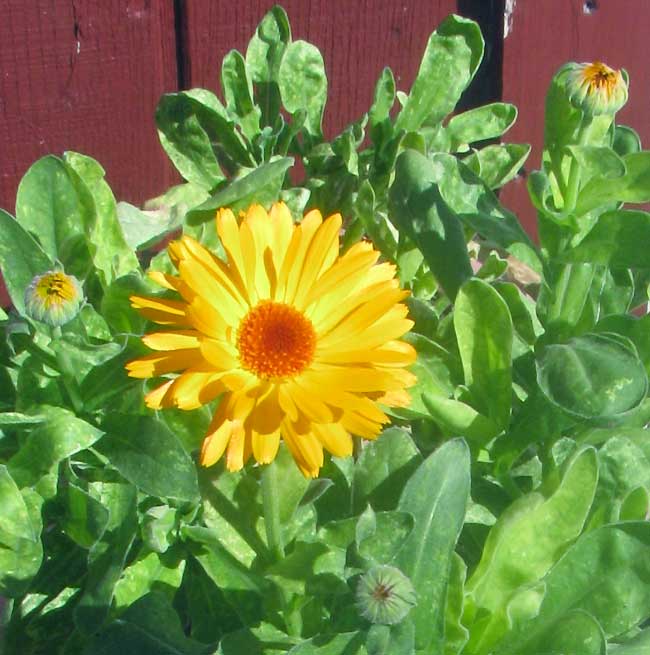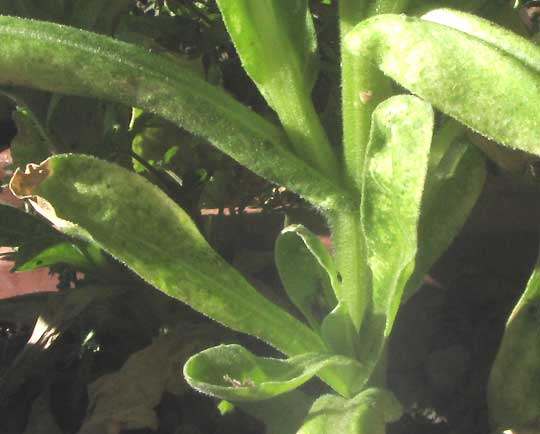Excerpts from Jim Conrad's
Naturalist Newsletter

from the February 17, 2013 Newsletter issued from the valley of the Dry Frio River in northern Uvalde County, southwestern Texas, on the southern border of the Edwards Plateau; elevation ~1750m (~5750 ft); N29.62°, W99.86°; USA
CALENDULA
When my Estonian lady friend Malle arrived here early last October she accidentally brought some flower seeds from Estonia, which we planted. Malle says the plant producing the seeds is much grown in Estonia with its short, cool summers, and its dried flowers are used in medicinal teas. She called the plant producing the seeds Saialill, which her dictionary translated into "Marigold." However, the seeds didn't look at all like Marigold seeds, nor did the plants arising from the seeds.
The plants grew, but not well during our months of ever-shorter days and colder temperatures. By the Winter Solstice they were droopy and had to be washed with detergent water every two or three days to keep down the aphids, which nonetheless kept sucking on them mercilessly.
Now with longer, sunnier days and springy temperatures the plants are beginning to look healthy and the aphids have practically disappeared, even though I no longer spray detergent water on them. This week they flowered, as you can see at the top of this page.
A pretty close-up showing tiny, reddish-orange disk flowers with their united anthers disgorging heaps of sticky pollen profiled against flaming yellow ray flowers in the background is shown below:

The flowering head of this member of the Composite Family has a bright center, or eye, unlike Marigolds, so on that account alone it's clear that our plant is not closely related to Marigolds. The button-shaped, unopened flower heads with their many involucral bracts in one or two series made me think of the fleabanes, genus Erigeron, though fleabanes aren't supposed to be yellowish. The leaves' manner of extending their blades gradually down their petioles to the stem also reminded me of the fleabanes, as shown below:

Now that the plants are flowering I can figure out who they were: It's CALENDULA OFFICINALIS, in English commonly called Pot-Marigold, even though the species has little to do with real Marigolds. Also it's called Calendula, that name sharing the same root as the word "calendar," the connection being that Calendulas blossom for a long time, "all through the calendar." Calendula is originally from the Mediterranean area, but now grows in gardens and pots worldwide.
On the evolutionary Tree of Life Calendula occupies a twig very near that of the fleabanes, so their similarity to the fleabanes is no coincidence.
Malle was right about the Pot-Marigold's dried flowers being much used in medicinal teas but maybe the plant is most effective against various types of skin inflammation, from infections to bee stings. A study in the 2009 issue of the Indian Journal of Experimental Biology showed that Calendula works by inhibiting the signaling molecules and enzymes that trigger the body's inflammatory response. Calendula also is strongly astringent, so it can be used for minor cuts and burns. A study reported in the 2009 issue of Phytotherapy Research described Calendula as one of the most effective herbs for inhibiting the growth of Campylobacter jejuni, a common bacterium causing severe diarrhea in children. Another study found that Calendula regulates the menstrual cycle and yet another that a Calendula extract killed cancerous melanoma cells and stimulated the immune system's white blood cells.
And Calendula's fresh or dried leaves, though a little bitter, are regarded as tasty additions to certain soups and salads.
What a pretty, tough, and generous little being this Calendula is. This is one annual plant I plan to grow year after year.